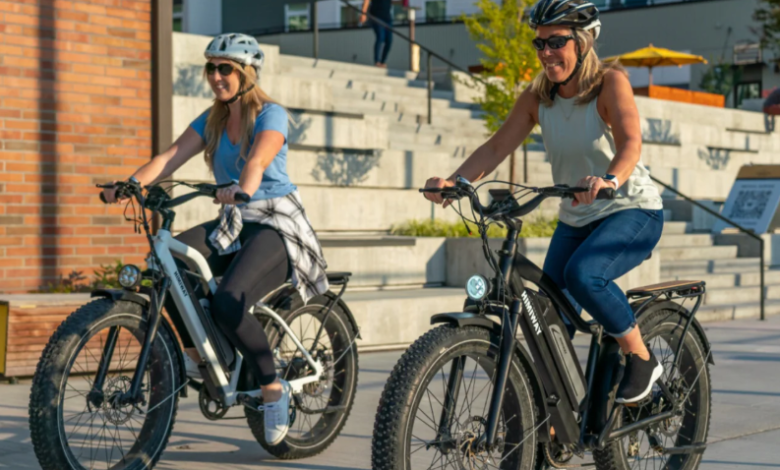How to Choose the Best E-Bike for Urban Living

Cycling has evolved from being just a hobby into one of the most sustainable and efficient ways to move around the city. With increasing traffic congestion, fuel costs, and environmental concerns, e-bikes have emerged as a practical and eco-friendly solution for modern urban commuters. Whether you’re looking for a faster way to get to work, a greener mode of transport, or simply a more enjoyable ride, e-bikes offer flexibility and freedom that few other options can match.
If you are exploring where to buy e-bikes in Switzerland, Dachzelthimmel provides a range of electric and folding bicycles designed for both city dwellers and adventure seekers who value sustainability and performance.
1. What Makes E-Bikes Ideal for City Life
E-bikes combine traditional cycling with electric assistance, allowing riders to travel longer distances with less effort. The motor provides a boost when pedaling uphill, against wind, or during long commutes, making them ideal for navigating city streets and hilly areas.
Key Benefits:
Eco-Friendly Transportation: E-bikes reduce your carbon footprint, supporting a cleaner urban environment.
Cost-Effective Mobility: Compared to cars or public transport, e-bikes have low maintenance and running costs.
Time Efficiency: Avoid traffic jams and parking hassles by using bike lanes or compact routes.
Health and Wellness: You still pedal—so it’s great for fitness without the exhaustion.
Accessibility: Perfect for all ages and fitness levels, thanks to motorized assistance.
Cities like Zurich, Basel, and Geneva are seeing a growing number of e-bike users who value both sustainability and convenience in their daily commutes.
2. Types of E-Bikes for Urban Commuters
E-bikes come in different categories, each designed for specific needs. Before buying, it’s important to understand which type matches your lifestyle.
a. City E-Bikes
These are designed for comfort and practicality. They usually feature upright seating, built-in lights, fenders, and luggage racks—ideal for commuting to work or running errands.
Best for: Everyday use, short-to-medium city rides, and relaxed commuting.
b. Folding E-Bikes
Folding bikes are compact and portable, making them perfect for small apartments or for combining cycling with public transport. They can easily fit into car trunks or under desks.
Best for: Multi-modal commuters and travelers with limited storage space.
c. Cargo E-Bikes
Cargo bikes come with extended frames or front boxes to carry heavy loads, groceries, or even children. Electric assistance makes pedaling easy, even when transporting extra weight.
Best for: Families, small business owners, or delivery riders needing a powerful and spacious bike.
d. Trekking or Hybrid E-Bikes
These offer versatility—great for both city streets and light off-road trails. With robust tires and comfortable geometry, they suit longer commutes or weekend adventures.
Best for: Riders who want one bike for multiple uses.
e. Speed Pedelecs
These are high-performance e-bikes that can reach speeds of up to 45 km/h, depending on local regulations. They’re ideal for long-distance commuters who need a quicker ride.
Best for: Experienced riders covering long distances regularly.
3. Factors to Consider Before Buying an E-Bike
Choosing the right e-bike involves more than picking your favorite color or style. You’ll need to consider your riding habits, local terrain, and personal comfort.
a. Motor Type
E-bike motors are typically categorized as:
Front Hub Motors: Offer smooth acceleration but can feel front-heavy.
Rear Hub Motors: Provide strong traction, ideal for hilly areas.
Mid-Drive Motors: Deliver balanced power and efficiency, perfect for steep climbs or longer rides.
b. Battery Capacity
The battery determines how far you can travel before recharging. For city commuting, a range of 40–100 km per charge is usually sufficient.
Removable batteries are convenient for charging indoors.
Integrated batteries offer a sleeker design and better protection.
c. Frame Design
Choose between step-through frames for easy mounting and dismounting, or diamond frames for a more traditional cycling posture. Aluminum and carbon frames are lightweight, while steel provides durability.
d. Comfort Features
Look for ergonomic handlebars, adjustable saddles, and suspension forks to absorb road vibrations.
e. Legal Requirements
In Switzerland, most e-bikes (up to 25 km/h) don’t require a license, but faster models (up to 45 km/h) are subject to different regulations and insurance requirements. Always check local laws before purchase.
See also: Hoptraveler.Com Travel Lifestyle: the Best Travel Tips
4. The Rise of E-Bikes in Switzerland
Switzerland’s well-developed cycling infrastructure, combined with growing environmental awareness, has made it a leading market for e-bikes. In many Swiss cities, dedicated bike lanes and charging stations make daily commuting both safe and practical.
Why Swiss Riders Prefer E-Bikes:
Hilly Terrain: Electric assistance helps riders navigate challenging slopes with ease.
Eco-Conscious Culture: Switzerland’s environmental values align perfectly with sustainable mobility.
Efficient Commuting: E-bikes provide reliable transport even in dense urban centers.
Government Support: Incentives and subsidies in certain regions encourage e-bike adoption.
Dachzelthimmel has recognized this shift and caters specifically to Swiss riders by offering e-bikes that combine performance, quality, and local relevance.
5. Comparing E-Bikes and Traditional Bicycles
While traditional bikes have their charm, e-bikes bring added convenience that makes daily commuting much easier.
| Feature | Traditional Bike | E-Bike |
| Effort | 100% human-powered | Pedal assistance for easy rides |
| Range | Limited by stamina | 40–100+ km per charge |
| Speed | Depends on rider | Consistent assistance up to 25–45 km/h |
| Terrain | Harder on hills | Effortless climbs with motor help |
| Commuting | More physical effort | Comfortable and faster travel |
E-bikes maintain the health benefits of cycling while making it accessible to more people, especially in cities with varied terrain.
6. Benefits of E-Bikes for Urban Living
a. Environmental Impact
E-bikes produce zero emissions during operation, making them a sustainable alternative to cars. When charged using renewable energy sources, they become nearly carbon-neutral.
b. Financial Savings
Owning an e-bike costs far less than maintaining a car. You save on fuel, parking, taxes, and insurance. Over time, this adds up to significant savings.
c. Fitness and Lifestyle
Unlike scooters or mopeds, e-bikes still require pedaling, promoting cardiovascular health and muscle tone—without causing fatigue.
d. Accessibility and Convenience
Older riders or those recovering from injuries find e-bikes helpful for staying active. They also eliminate the barriers of long distances or steep roads.
e. Family and Community Benefits
With cargo e-bikes, families can replace a second car for school runs or shopping trips, encouraging more sustainable habits.
7. Maintenance Tips for E-Bikes
Maintaining your e-bike ensures longevity and consistent performance. Fortunately, they require similar care to regular bicycles, with a few extra considerations.
Battery Care
Charge regularly but avoid overcharging.
Store batteries in a cool, dry place.
Avoid full discharge to prolong lifespan.
Motor Maintenance
Clean gently with a damp cloth—avoid high-pressure washing.
Have professional servicing once or twice per year.
Tire and Brake Checks
Ensure proper tire pressure for safety and range efficiency.
Inspect disc brakes frequently for wear.
Software Updates
Modern e-bikes often feature smart displays or Bluetooth connectivity. Keep software up to date to enhance functionality.
8. Accessories to Enhance Your Ride
E-bikes offer endless customization options. Some essential accessories to consider include:
Helmets: Safety first—choose certified models with proper ventilation.
High-Visibility Clothing: Make sure you’re visible in traffic, especially at night.
Panniers or Baskets: Add storage for groceries, laptops, or personal items.
Locks: Invest in high-quality locks to protect your e-bike.
Lights and Reflectors: Ensure compliance with Swiss road safety standards.
Many of these accessories can be found alongside e-bike offerings on Dachzelthimmel, where design meets practicality for everyday riders.
9. Sustainability and the Future of Urban Transport
E-bikes represent a key component of sustainable mobility. As cities prioritize cleaner transportation systems, e-bikes are being integrated into urban planning through dedicated lanes and public rental programs.
Sustainable cycling doesn’t just benefit the environment—it also supports mental health and local economies. More cycling means less noise pollution, healthier citizens, and reduced dependency on fossil fuels.
By choosing an e-bike, you contribute to a greener, quieter, and more livable city.
10. How to Find the Perfect E-Bike for You
Here’s a step-by-step guide to help you make an informed decision:
Assess Your Needs: Commuting, leisure, cargo transport, or adventure riding?
Set a Budget: Quality e-bikes are an investment that pays off long-term.
Test Ride Before Buying: Comfort and control are key—try different models.
Consider After-Sales Support: Reliable warranty and servicing are essential.
Check Local Laws: Speed limits and helmet requirements vary by region.
For those in Switzerland, browsing trusted suppliers like Dachzelthimmel is an excellent starting point to compare models, features, and pricing for e-bikes suited to local needs.
11. Conclusion
E-bikes have transformed how we move through our cities. They offer the perfect blend of convenience, sustainability, and freedom—empowering individuals and families to make smarter transportation choices. Whether you’re a daily commuter, a weekend explorer, or a parent seeking a sustainable alternative to driving, e-bikes make mobility effortless and enjoyable.
To explore a wide range of eco-friendly electric bikes and discover which model fits your lifestyle best, visit dachzelthimmel.ch — your trusted source for high-quality e-bikes in Switzerland designed for modern urban living.







